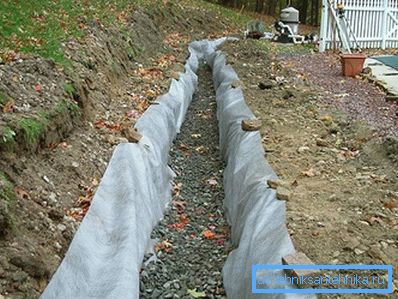Underground site drainage
Only a few years it will take groundwater and meltwater to destroy the foundation of the new building. To avoid this, it is necessary to build an underground drainage area. Such a system will divert excess water and will not allow it to destroy buildings and turn the entire territory into a marsh after a heavy rain. And how to make such a system on their own, and we will tell in this article.
Used fixtures

Before you start installing the underground drainage system with your own hands, you need to know what tools and materials are used for this. The main component is the pipe.
For drainage use two types of pipes:
- drains;
- porous structures.
The first ones are a pipe with perforations made over the entire surface. With their help, water from the soil gets inside and is displayed outside the site. There are no holes in the porous tubes. Moisture enters them directly through the walls, made by a special technology.

Tip! The material used is mainly PVC and polyethylene. This allows you to increase the service life of products up to 50 years. Polymeric materials have high wear resistance, durability and easily tolerate the aggressive effects of soil and water in it.
Pipes for drainage systems are available in diameters from 110 to 200 mm. Also, the length of such products may be different. As a rule, it is 40 or 50 meters. The surface of the pipes can be smooth or corrugated. The latter option is more resistant to mechanical stress.

Another component of the drainage system from the site are drainage wells. Such designs are necessary for courting the system. They can be made of concrete or polymers. There are inspection and wells for pumping water. The latter can be equipped with attachments for pumps.
Inspection drainage wells are installed at the joints of pipes or at the site of bends. They can be used to clean the system using a large water pressure.

Tip! Various pipe fittings are used to connect the pipes. It can be couplings without a seal, rigid and flexible pipes and other devices.
In addition, a water intake well may be included in the system. It is installed at the lowest point of the site. All drainage pipes for collecting water are supplied to it. In the future, the liquid can be used for irrigation or technical needs. But, as a rule, such wells are rarely installed. Basically, all collected water is taken outside the site into natural or artificial reservoirs, ditches, or a central storm sewer system.
Installation of underground drainage system

To make groundwater drainage, need large-scale earthworks. But the first step will be to create a scheme for the future system. It is necessary to determine the location and direction of natural slopes and water accumulation sites. To do this, you can use special equipment (a level or a laser range finder) or determine everything empirically, watching the drains after the rain.
Then the scheme is transferred to the site and the marking is done (for this you can use pegs with stretched ropes). By marks digging trenches. Their depth must be done below the base of the foundation. To save time and effort, it is advisable to lay the drainage system and stormwater in one trench.
Tip! When digging trenches it is necessary to observe a bias towards the lowest point on a site. Slope level must be at least 2 cm per linear meter.
Then a layer of rubble, up to 10 cm thick, is poured onto the bottom of the trench and compacted. Now you can lay pipes. In places of bends are used flexible pipes. And between themselves the pipes are connected by couplings without seals or solid pipes.

Then the pipes are filled with clean gravel or rubble, with a fraction size of 16 × 20 mm. The thickness of this layer will depend on the permeability of the soil. Than this figure is less, the thicker the layer of gravel or rubble.
The remains of the trench are covered with soil. At the same time it is necessary to choose from it all large stones and solid pieces of earth. It is advisable to use geotextiles as a layer between the soil and the layer of gravel. It will not allow the earth to shower and block the permeable layer (gravel).
Drainage wells are installed at the site of pipe bends. To do this, dig a pit of the desired size. At its bottom fit a pillow of sand or rubble, which is compacted. Then a well is installed and drainage pipes are connected to it. After this is done backfilling with primer.
If a water intake well is used, it is installed at the lowest point of the site. As a rule, it is a large container of concrete or other material. All drainage pipes should converge to it.
Video
This video is about the drainage area. It will contain tips and recommendations on the arrangement: